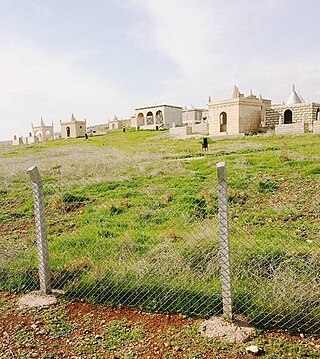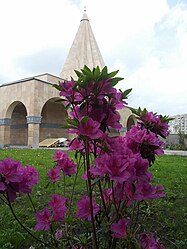
Tawûsî Melek is one of the central figures of the Yazidi religion. In Yazidi creation stories, before the creation of this world, God created seven Divine Beings, of whom Tawûsî Melek was appointed as the leader. God assigned all of the world's affairs to these seven Divine Beings, also often referred to as the Seven Angels or heft sirr.

Yazidism, alternatively Sharfadin, is a monotheistic ethnic religion, that originated in Kurdistan and has roots in a western Iranic pre-Zoroastrian religion directly derived from the Indo-Iranian tradition. It is followed by the mainly Kurdish-speaking Yazidis and is based on belief in one God who created the world and entrusted it into the care of seven Holy Beings, known as Angels. Preeminent among these Angels is Tawûsî Melek, who is the leader of the Angels and who has authority over the world.

Lalish is a mountain valley and temple in Shekhan, Duhok Governorate in Iraqi Kurdistan. It is the holiest temple of the Yazidis. It is the location of the tomb of the Sheikh Adi ibn Musafir, a central figure of the Yazidi faith.
Yazdânism, or the Cult of Angels, is a pseudohistoric pre-Islamic religion with claimed ties relating to a Mithraic religion of the Kurds. The term was introduced and proposed by Kurdish and Belgian scholar Mehrdad Izady to represent what he considers the "original" religion of the Kurds.

Yazidis in Armenia are Yazidis who live in Armenia, where they form the largest ethnic minority. Yazidis settled in the territory of modern-day Armenia mainly in the 19th and early 20th centuries, fleeing religious persecution by the Ottoman Empire. While Yazidis were counted as Kurds in censuses for much of the Soviet period, they are currently recognized as a separate ethnic group in Armenia. According to the 2011 census, around 35,000 Yazidis live in Armenia.

The Kurds in Armenia, also referred to as the Kurds of Rewan, form a major part of the historically significant Kurdish population in the post-Soviet space, and live mainly in the western parts of Armenia.
Sheikh Hasan ibn Sheikh ‘Adī II is a holy and historical figure in that is revered in Yazidism and considered the physical or earthly incarnation of Melik Şêxsin, one of the Seven Divine Beings to whom God assigned the World's affairs. Melik Şêxsin is associated with the Pen and consequently with writing and books, he is thus called Xudanê Qelemê. Adani Sheikhs are the descendants of Sheikh Hasan and were traditionally the only ones in Yazidi society that had the privilege to acquire the art of writing and reading.

Yazidis, also spelled Yezidis, are a Kurdish-speaking endogamous religious group who are indigenous to Kurdistan, a geographical region in Western Asia that includes parts of Iraq, Syria, Turkey and Iran. The majority of Yazidis remaining in the Middle East today live in Iraq, primarily in the governorates of Nineveh and Duhok.

Khurto Hajji Ismail was the Baba Sheikh of the Yazidis until his death in 2020. He held this position since 2007. He lived in Ain Sifni, Iraq.

The Kurds in Georgia form a major part of the historically significant Kurdish population in the post-Soviet space, and are members of the eponymous ethnic group that are citizens of Georgia. In the 20th century, most Kurds fled religious persecution in the Ottoman Empire to the Russian Empire. The return of their Kurdish surnames needs effort according to a Kurdish activist in Georgia. The Kurds also have their own schools, school books and a printing press in Georgia. Illiteracy among them disappeared in the early 1900s. Kurds in Georgia are politically neutral; however, in 1999 they staged a huge demonstration in Tbilisi, demanding the release of the founder of the Kurdistan Workers' Party, Abdullah Öcalan. Kurds in Georgia today use Cyrillic script. Earlier, in the 1920s, they used the Latin script.

The main religions that exist or historically existed in Kurdistan are as follows: Sunni Islam, Shia Islam, Christianity, Zoroastrianism, Yarsanism, Yazidism, Alevism and Judaism. Overall today, Sunni Islam is the most adhered to religion in Kurdistan.

Yazidis in Syria refer to people born in or residing in Syria who adhere to Yazidism, a strictly endogamous religion. Yazidis speak the Kurdish language of Kurmanji. Although some are scattered in Turkey and the Armenia, Iraq is the center of their religious life, the home of their Amir, and of the tomb of their most revered saint, Sheikh Adi. Yazidis in Syria live primarily in two communities, one in the Al-Jazira area and the other in the Kurd-Dagh.

Yazidism in Turkey refers to adherents of Yazidism from Turkey, who remained in Turkey after the dissolution of the Ottoman Empire. The Yazidis living in Turkey during and after the second half of the 20th century gradually left for European countries. In the 1980s, there were 60,000 Yazidis situated in Beşiri, Kurtalan, Bismil, Midyat, Idil, Cizre, Nusaybin, Viranşehir, Suruç and Bozova. Today, these places are almost empty due to exodus to Europe which was provoked by political, religious and economic difficulties. Today only small number remain in villages around Midyat, Viranşehir, Çınar and Beşiri. According to the census of 2000, only 423 individuals adhering to Yazidism remained in the country.
The Yazidism in Russia refers to believers of Yazidism in Russia. This community is part of the Yazidis who emigrated to Russia from the Armenian and Georgian parts of the Soviet Union after the collapse of the Soviet Union in the 1990s. In 2009, the Yazidis were recognized as a religious community in Russia.

The persecution of Yazidis has been ongoing since at least 637 CE. Yazidis are an endogamous and mostly Kurmanji-speaking minority, indigenous to Kurdistan. The Yazidi religion is regarded as "devil-worship" by Muslims and Islamists. Yazidis have been persecuted by the surrounding Muslims since the medieval ages, most notably by Safavids, Ottomans, neighbouring Muslim Arab and Kurdish tribes and principalities. After the 2014 Sinjar massacre of thousands of Yazidis by ISIL, which started the ethnic, cultural, and religious genocide of the Yazidis in Iraq, Yazidis still face discrimination from the Iraqi government and the Kurdistan Regional Government.
There is a social organizational structure in the Yazidi community. There are three main castes, namely the Mirids, the Sheikhs, and the Pirs. Furthermore, there are positions for dignitaries in the Yazidi hierarchy.

Yazidism in Iraq refers to adherents of Yazidism from Iraq who reside mainly in the districts of Shekhan, Simele, Zakho and Tel Kaif, in Bashiqa and Bahzani, and the areas around Sinjar mountains in Sinjar district. According to estimates, the number of Yazidis in Iraq is up to 700,000. According to the Yazda aid organization, just over half a million Yazidis lived throughout Iraq before August 2014.

The Yazidi New Year (Sersal) is called Çarşema Sor or Çarşema Serê Nîsanê in Kurmanji. It falls in spring, on the first Wednesday of the April and Nîsan months in the Julian and Seleucid calendars, i.e. the first Wednesday on or after 14 April according to the Gregorian calendar.
Pîr Xidir Silêman was a Kurdish-Yazidi writer, teacher and parliamentarian. He was born 1952 in the town of Ain Sifni in Shekhan, Iraq. He completed his secondary education in Shekhan in 1970 and studied Kurdish language and literature at the University of Baghdad. In 1974-1975, he worked as a translator for Dengê Kurdistan Radio and in 1977 he became Kurdish language teacher in Shekhan. In 1979, he joined Kurdish Writers' Union, of whom he became the president from 1991 to 1997, making him the first Yazidi to run the Union. He was also the editor-in-chief for their magazine. From 1992-1997, he was the president of Lalish Cultural Center, which he co-founded and was established in 1993 to archive and preserve Yazidi culture and history. He also edited for Lalish Magazine, which was owned by him until his death. In 2005, he became a member of Kurdistan Parliament. On 14–15 November 2021, he suffered a stroke at his home in Shekhan and was taken to Azadi Hospital in Duhok, where he died some hours later due to heart attack.
Alphabetical index of articles about the Yazidis, and their history and culture.












